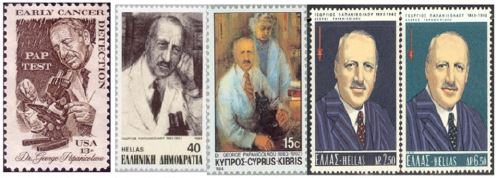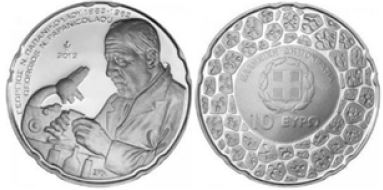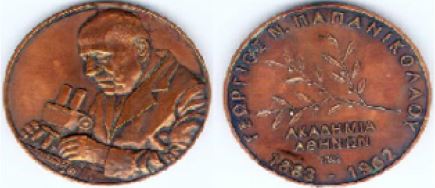Georgios Papanikolaou and Part-Test in the Reflection of Collecting Means
ABSTRACT
The article presents the results of the research concerning the reflection of the scientific and research activities of the famous Greek scientist Georgios N. Papanikolaou and the development of the world famous and used in gynecology and oncology, his famous PAP-test, for the definition of papillomavirus infection. All materials presented in these articles were illustrated with the help of philately, faleristics, bonistics and numismatics. The article is of interest for doctors, medical workers of different directions, students and historians of medicine, collectors and a wide range of readers.
KEYWORDS
Papanicolau; Papillomavirus infection; PАР-test, Philately; Postage stamps; Faleristics; Numismatics; Commemorative medal; Banknote; Coin
ABBREVIATIONS
(EFD): Envelopes of the First Day; (AME): Art Marked Envelopes
INTRODUCTION
The history of medicine knows many of its heroes who have contributed to the fight against the many diseases that afflict humans. Among these diseases that affect and kill women of different ages, cervical cancer occupies a special place. In this article I would like to tell you about a special person, a researcher, a scientist, a hero of medicine, a glorious son of the Greek people, a world-famous fighter against cervical cancer - Georgios Nikolaou Papanicolaou [1, 2].
The microorganisms that lead to atypical changes in the epithelium of the affected organ are named after him, as well as the world-famous screening test (PAP test), which will be discussed below. Georgios Nikolaou Papanikolaou was a Greek scientist, physician, pioneer of cytology and early diagnosis of cancer. The Papanicolaou test is now used worldwide to detect cervical cancer in women at early stages of the disease [2-5]. The method of cytological examination of cervical and cervical canal cells by smear on glass was developed more than eighty years ago by Papanicolaou, whose name was later given to the method. Since 1943, the RAR test has been widely used worldwide as a screening test for the diagnosis of cervical cancer and precancerous conditions [6].
AIM
The purpose of this article is to present the results of a special study devoted to the presentation of the memory of G. N. Papanicolaou and his PAP-test in the reflection of such collectibles as philately, numismatics, and bonistics.
MATERIALS AND METHODS
To achieve this goal we used such methods of research as the analysis of available sources of information, using special literature and the history medicine, Internet resources, philatelic catalogs, directories and thematic articles.
RESULTS AND DISCUSSION
I would like to tell the story of the scientific exploit of G. N. Papanicolaou in a way that is not quite usual, namely to show how the story of a hero of medicine can be conveyed by telling about him and presenting his activities, in the reflection of collection tools as material sources of information transmission. To begin my story, I would like to start with philately, an auxiliary science [1], in which postage stamps, envelopes, blocks, cartomaxims, and more are represented. There are postage stamps of the United States, Greece, and the Republic of Cyprus, dedicated to G.N. Papanicolaou and his scientific discovery, which are shown in (Figure 1). On the Cyprus stamp the scientist is depicted with his wife and assistant, Andromache Papanikolaou [7-9].
More widely and diversely represent the scientific feat of the scientist, envelopes of the first day (EFD) and art marked envelopes (AME), of which there are several dozen, with a variety of artistic illustrations and postage stamps on them, some of which are presented in (Figure 2); [7-9].
We would also like to present a small selection of postage stamps and art stamped envelopes from several countries of the world devoted to the fight against cervical cancer, shown in (Figure 3).
In memory of the glorious son of the Greek people, a banknote of 10,000 Greek drachmas was issued in 1995, depicting the scientist and the dates of his life, the objects of his workplace - microscope, laboratory equipment, books, notes. This banknote, on the front side, is shown in (Figure 4); [10].
In memory of the Greek scientist, in 2012, the Greek government issued a silver commemorative coin, denominated 10 euros, which (obverse and reverse), shown in (Figure 5); [4]. The obverse of the coin depicts G.N. Papanicolaou sitting at a working microscope, with a smear in his hands. The obverse of the coin is framed by inscriptions of his name, surname and life dates, presented in Greek and English. The reverse features a stylized cytological swab (PAP test), and frames the coat of arms of Greece, and the denomination of the coin, 10 euros, written in Greek [4].
In conclusion, we would like to present a commemorative bronze medal of the Greek Academy of Sciences (Athens), minted in memory of the great Greek scientist. This medal (obverse and reverse) is presented in (Figure 6) [4].
CONCLUSION
1. The postage stamps, commemorative medals and coins, and banknotes of the world show quite richly various aspects of the scientific activities devoted to the discovery of papillomavirus infection and the development of the screening PAP test by the Greek cytologist Georgios Nikolaou Papanikolaou.
2. Collectibles, as means of material culture, are an informative means of narrating the lives of medical scientists, as well as a valuable illustrative addition to the study of the history of medicine.
CONFLICT OF INTEREST
The author notes the complete absence of any conflicts of interest.
REFERENCES
- Bugaevsky KA, Bugaevskaya NA (2016) Biochemistry in the mirror of collection. bulletin of the council of young scientists and specialists of the Chelyabinsk region 4(15): 21-29.
- Vilos GA (1998) The history of the Papanicolaou smear and the odyssey of George and Andromache Papanicolaou. Obstet Gynecol 91: 479-483.
- Michel (2013) Catalog “Michel” of the whole things of Europe and the world. Ed by B Albert Edition 8th. Without place of publication p. 1098.
- (2022) High priest memorial for G papanikolaou. Eviaportal gr - Attica.
- Alexander M (2013) Bank of Greece receives multiple nominations at 2014 coin of the year awards. Coin Update.
- Chemo philately museum: George Papanicolaou, pap test of cervical cancer.
- Why didn’t they give the Nobel prize to George Papanikolaou who discovered the life-saving pap test? They excluded the Greek scientist by mistake.
- George Papanicolaou Biography (1883-1962).
- Honouring George Papanicolaou (1883-1962) Block of Stamps Original First Day Cover at Amazon’s Entertainment Collectibles Store.
- (2015) Scott specialized catalogue of worlds stamps. Scott HE6185. 55th Edn, New York, USA, p. 876.
Article Type
Short Communication
Publication history
Received Date: June 21, 2022
Published: July 29, 2022
Address for correspondence
Bugaevsky KA, The Petro Mohyla Black Sea State University, Ukraine
Copyright
©2022 Open Access Journal of Biomedical Science, All rights reserved. No part of this content may be reproduced or transmitted in any form or by any means as per the standard guidelines of fair use. Open Access Journal of Biomedical Science is licensed under a Creative Commons Attribution 4.0 International License
How to cite this article
Bugaevsky KA. Georgios Papanikolaou and Part-Test in the Reflection of Collecting Means. 2022- 4(4) OAJBS.ID.000476.
Figure 1: Postage stamps dedicated to G.N. Papanikolaou.
Figure 2: Postal envelopes dedicated to G.N. Papanikolaou.
Figure 3: Philatelic materials devoted to the fight against cervical cancer.
Figure 4: Greek banknote of 10,000 drachmas in memory of G.N. Papanicolaou.
Figure 5: Greek 10-euro coin dedicated to G.N. Papanicolaou.
Figure 6: Commemorative medal of the Academy of Sciences of Greece dedicated to G.N. Papanicolaou.








